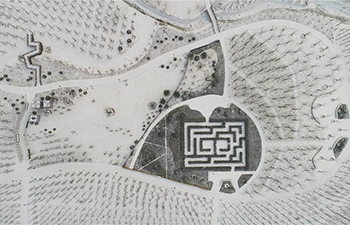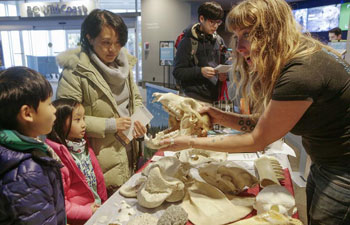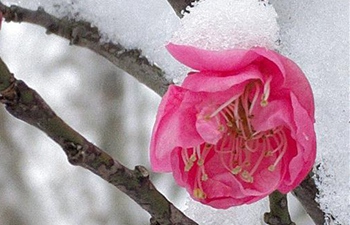URUMQI, Jan. 29 (Xinhua) -- Zulfida Daman and Diwanisa Mayil were too excited to feel the winter cold on their big wedding day.
Daman, 24, sat at her parents's home in Baidir Township, Taxkorgan Tajik Autonomous County in northwest China's Xinjiang Uygur Autonomous Region.
While her aunt made some last-minute adjustments to her dress, Daman looked out through her bedroom window. She saw her family and neighbors partying, singing and dancing under the snowy mountains of Pamir Plateau. The man she was waiting for had not shown up yet.
The groom Mayil was on the way to her home. He did not notice as the car sped past picturesque snowy mountains and sapphire lakes, raising dust on the country road. All he was thinking about was the moment when he confessed his feelings to Daman for the first time when they were in high school.
But his dream girl was not interested in puppy love at that time.
Now with white dots painted around his eyes, a traditional Tajik wedding custom, Mayil could not help smiling at the thought that she was about to become his wife.
He did not give up his pursuit until Daman finally accepted his love in their sophomore year. While studying at separate colleges 660 kilometers apart, the lovebirds traveled during weekends to see each other. They were finally together when they graduated and returned to work in their hometown.
"If I cannot marry you, I will not marry anybody else," Mayil said when he proposed to Daman. She said yes and they began to plan their wedding.
About 80 percent of the population in the county is ethnic Tajik. Traditions are well preserved on the plateau. In contrast to Han weddings held across most parts of China, Tajik weddings are usually held in the bride's home. On the morning of the big day, the groom, his best man and family go to the bride's home with gifts, particularly a goat, playing folk music along the way.
Mayil wore a pakol, a Tajik headwear with red and white ribbons. Traditionally white signifies purity while red means happiness.
When arriving at the bride's home, Mayil greeted everyone with a typical Tajik gesture -- grasping each others' hands and kissing the others' knuckles. Mayil was anxious to see his bride, but his patience must be tested before his companions can join the bride's family at the party.
They danced, imitating the soaring of an eagle, a totem of Tajik people. They also sang to the music played with eagle bone flutes.
Then Mayil finally saw his bride, veiled in red and white, walking out of her bedroom.
A guest began to play the tabour, a small drum. It is tradition to invite someone who has just experienced the loss of a family member to play for the wedding, to symbolize letting bygones be bygones, and giving blessings to the couple.
The drumming of tabour started the ceremony. The couple swore their vows before the guests and drank from a cup of tea, indicating their shared life and lasting love. Then Mayil's mother gave Daman a ring as a token of recognition of her new daughter-in-law.
After the ceremony and feast, it was time to bid the bride farewell. Holding Daman tightly in her arms, her mother Nurbiya couldn't help bursting into tears. She whispered something to her daughter, and let her go.
Daman got into the car, and headed to her new home and new life.
















